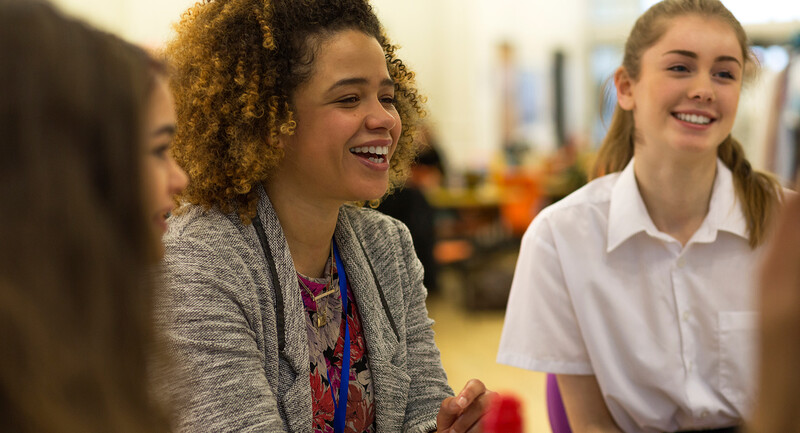Cooperative learning is valuable in its own right, but it is especially useful in helping to teach and model social and emotional learning (SEL) skills, like listening, teamwork, and relationship building. It is one of the many instructional strategies used by the 21 school districts that participate in CASEL's Collaborating Districts Initiative. These districts are committed to a systemic approach to social and emotional learning. This approach simultaneously focuses on building equitable learning environments across schools and classrooms, explicitly teaching social-emotional competencies, and integrating SEL competencies into content and instruction. Cooperative learning is one way that this integration of SEL and academic instruction comes to life in classrooms.
Cooperative learning requires that students work to collectively complete goals. This approach provides students with opportunities to practice and reflect on their social and emotional competencies as they also develop their academic ones, whether they are working on a math problem or discussing a book. They learn to support and challenge one another, drawing on their relationship skills and their ability to make responsible decisions that serve the individual and collective good. They also learn to articulate their ideas, explain material to their peers, and use metacognition as they reflect on their own thinking while still remaining open to their peers' perspectives.
This requires a great deal of social and self-awareness. Cooperative learning also reinforces positive academic mindsets by asking students to take on challenging material in a way that feels supported and social (Marzano, Pickering, & Pollock, 2001).
Key Elements of Cooperative Learning
The central elements of cooperative learning are (Johnson & Johnson, 1989)
- Positive interdependence: When students understand that their success depends on the success of the group, they will take the time to help one another master the material. This builds social awareness and motivates students who may be used to achieving below their potential.
- Individual and group accountability: Students must also be held accountable both for their own learning and the group work, which promotes self-management, social awareness and responsible decision-making.
- Promotion of others' success: The teacher helps students develop relationship skills by encouraging students to celebrate one another's efforts and brainstorming positive ways to support peers who are struggling. It is also beneficial to model and have students practice negotiating the specific encounters within their group. For example, the teacher may ask students to brainstorm ideas for how they might appropriately respond to a teammate who is getting off task.
- Group processing: As students take on more responsibility for their own learning, have them discuss and reflect on how they are doing as a group to guide their participation and promote responsible decision-making.
SEL in Action: Cooperative Structures
How might cooperative learning play out in a classroom?
Let's say a teacher named Mr. Greene is excited to engage his students in cooperative learning, but the last time he tried it, some students seemed to do most of the work while others were disengaged. Whenever he goes to support a group of students, another group across the room goofs off. He wonders if the students have the self-awareness or self-management to engage with the tasks productively. "But if I don't give them the chance to practice," he muses, "how can I expect them to get better?"
Mr. Greene decides he will facilitate a discussion about how relationship skills—including the ability to work together—help in school and career. He then works with students to establish norms for group work by asking what it will look like, sound like, and feel like to collaborate effectively. Next, he asks students to come up and model ways to handle potential encounters in their group, such as one student moving forward too quickly or a disengaged classmate.
As students rehearse responses to potential challenges, Mr. Greene asks them to think about the relationship skills they have learned in explicit instruction, including how to give feedback and listen actively. He frequently reinforces that the goal of group work is that all members learn the material, not merely that the work gets completed.
After giving clear instructions and checking for understanding, Mr. Greene moves around the classroom as the students work. He stops by each group to pose a question that will push their thinking forward or to make an observation about what he notices in their group collaboration, but he doesn't stay with any one group for too long.
Later, each group has an opportunity to share out their big ideas. Students also have a chance to reflect on how they did both as a group and as individual team members. Mr. Greene points out strengths he observed and asks students to reflect on what they could do differently.
Setting the Stage for Cooperative Learning
To ensure that all students feel supported, include tools such as graphic organizers, keep groups small (six or fewer), and preteach any vocabulary or concepts in order to help students who may struggle to participate fully.
Just as with direct instruction, plan what you want students to know, understand, or explore. Then, determine how to structure the activity meaningfully and assess whether students have reached the objectives.
To ensure that students collaborate, contribute equitably, and resolve conflicts effectively, be clear about
- Student roles (summarizer, spokesperson, timekeeper, questioner);
- The order of tasks;
- Communication signals for when the group needs assistance; and
- Norms for using materials and equipment.
For example, a teacher in one of our partner districts has students read and discuss a political speech in groups of five. Within those groups, students will be assigned to be timekeeper, materials manager, "air time" monitor, summarizer, and presenter so that all students own the process of discussing equitably, summarizing their learning, and presenting back to the class on key points that will support collective understanding.
Teachers who have used cooperative learning report that they spend less time managing their classrooms (Gibbs, 2006). This allows them to act more as coaches or facilitators, challenging and encouraging students' learning. However, teachers do intervene when necessary to improve both group functioning and students' understanding of content.
The guidance in this article was adapted from the CASEL Guide to Schoolwide SEL, a free online resource for implementing systemic SEL.







